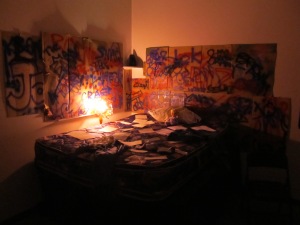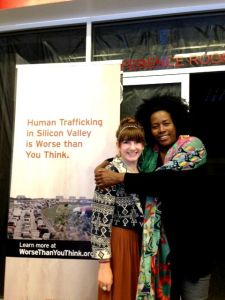The Freedom Exhibit– a Post- Reflection
August 3, 2013 12:00 AM
I am high off of the excitement of advocacy. There is so much power in talking to people about the things that drive me, and having them care. I felt the sparks of awareness flying tonight. I feel as if I have lowered a rope into a pit of ignorance and hoisted some people out of it. I think I may have even flung some of those people from the flat ground of awareness into the realms of action.
.
Over the last couple months, I have become more and more competent in my abilities to discuss human trafficking with people that share the same passions. I preach to the choir like a pro– I have had many a car conversation, many a dinner table education with my parents. But when I try to talk to people who don’t share my passion, I have felt tongue tied. I haven’t known how to breach the topic, and once I do, I don’t know where to start. Tonight, that changed.
I completely overwhelmed the first woman I talked to. I overloaded her with way too much information about every organization I could describe on our “Learn” table. I could see the stars coating her eyes, the confusion clouding her vision. When she stopped me and asked, “Wait… what is human trafficking?” I knew I had to take a different approach. I had spewed word vomit all over her, and really not brought her any closer to an understanding of human trafficking.
.
That was when I realized that I could use the scene I had created as a presentation tool. My art piece provided me with a catapult to educate, something I had really been lacking. I brought people in, at first one on one, and then as groups and told them this:
.
~ First look at this mattress, this graffiti, these papers. What do you see? What do they make you think about?

Now when people think about human trafficking, their minds immediately jump to sex. People know about brothels, about people being trafficked across borders in other nations to provide sex to customers. But human trafficking is truly a multifaceted issue. This bed could be the bed in a brothel, but it could be inhabited by so many different people.
.
This is the bed of a boy, who is arisen every morning, thrown into a van with six other guys, handed a couple dozen crates of strawberries, and dropped off at a street corner. He is told he has to sell all of the strawberries or be beaten. He goes out, selling strawberries all day. You have seen this boy, sometimes outside Costco, sometimes outside Safeway. You may even have bought strawberries from this boy. In the evening, he is picked up in the van by his pimp. He has not had a lunch break. He has not been able to go to the bathroom. Today, he hasn’t even sold all of his strawberries. In punishment, after handing the money he has made to his pimp, he is raped. This is the bed he goes back to and cries in.
.
Or this is the bed of a girl whose family is abusive. Her parents are drug abusers or they beat her. Maybe she doesn’t have parents at home at all. She runs away from home, and while walking the streets is picked up by a boy. He takes her in; he gives her gifts. He tells her he loves her. He fills a gap that has been empty; he makes her feel special. She falls in love with him. He calls her his girlfriend. After a little while, though, he tells her she needs to make up her share of the income. He tells her she can’t just sit home all day. So he drops her off on the streets to pick up customers. This is the bed that she brings five, ten, fifteen men a night to, selling her body to make money for her “boyfriend”.
.
Or is this is the bed of a woman who has just immigrated to America from Cambodia. She wants to start a new life in the land of opportunity. She is offered a job at a nail salon, but is told that instead of payment, they will give her a room in the back. She is not allowed to leave the salon unsupervised. The only time she is allowed out of this room, is when she is painting nails. She doesn’t know her rights. She doesn’t know she is entitled to more than this. This is the room that she spends her days and nights in.
.
This bed represents the millions of people stuck in human trafficking today. And splayed across it are diary entries, prayers, poems. On the walls are cries for help, all scribbled across the oppressive graffiti that surrounds the people contained within its walls. These are written pleas for help, because so many of these people do not have the use of their voices to ask for help. They are scared. Women do not want to be arrested for prostitution. Girls are so in love with their pimps, that they do not realize that they are being manipulated. Their emotions are so toyed with, so disjointed that they do not know who to trust or where to turn for affection. Illegal immigrants trafficked in the agricultural industry don’t want to be deported. Legal immigrants do not know their rights. People who have been trafficked into the US do not realize that they have rights to trafficking visas. People are blocked by language barriers, trust barriers, emotional barriers.
.
And it starts so young. The average age of a trafficking victim in the US is 12, but people are weaned into it from even earlier. Children are burdened by emotional, physical, and sexual abuse. They are neglected by their parents. They are not raised with a sense of self- worth or confidence in their abilities. They seek love anywhere they can find it.
.
The system is so skewed. There are more people in slavery now, in 2013, than there were during the entire length of the transatlantic slave trade combined. And back then, slavery was legal. It was in the public eye. It was contested by some, but accepted by most. Now, it is an underground criminal industry. Not just any criminal industry, but a particularly profitable one– the 2nd most profitable criminal industry, netting about $32 billion a year. Once a person sells a gun, that gun is gone. But a person can sell a girl again and again and again and again. A person pimping four girls can make about $600,000 a year. There is a demand for it. It is consumed in mass quantities. With inflation calculated in, a slave back in the 1800s was worth about $30,000. Now, a slave can be bought for $90. Our sense of human worth seems to have plummeted by a long shot. And this is just the beginning of the story. ~
Now, I talked and people listened… really listened. People asked questions… good questions. They started recognizing the signs. People told me about situations that had before not seemed odd, but now seemed like signs of human trafficking. They disclosed information about family, neighbors, friends who had been involved in the issue. They wanted to know how to pinpoint the indicators, how to act, what to look for, and how they could get involved. They wanted to know about the children, about the laws, about the numbers, about the history; I could tell them. I have done so much research- speaking to people, listening to stories, watching documentaries- that I was able to truly advocate. I was able to back up my fictional (yet completely plausible) pieces with hard numbers.
And I was not alone in my advocacy. I was joined by two truly inspiring women. Julia Wood, the girl who had kickstarted the concept of an art exhibit and collected the art pieces, and I worked off of each other with the most collaborative chemistry. People would ask questions, and we were able to teach together, to fill in each others’ gaps in knowledge, and to combine our separate insight into a truly comprehensive understanding of human trafficking. Most notably, I was joined by Regina Evans, a survivor of the Life, who has since channeled her complex emotions into poetry and a one woman play.
She shared her story, her passion, her pain, and her love. She lured people into the back room with the bed setup and performed a rhythmic telling of her story… She started with an almost abstract poetic description of a girl being raped, abused, sold on the streets. “She’s somebody’s baby. She’s somebody’s child,” was her haunting refrain. But as her tale escalated, the pronoun turned personal, and the audience was drawn further into her tortured eyes, and her trembling hands. “I’m somebody’s baby,” she whispered, her voice cracking, “I’m somebody’s child.” At the end of her performance, she turned to the numbers, warning of the 300,000 children at risk of trafficking in the US alone. She called people to action. She appealed to them to stand by no longer. As people walked out of that room, the reactions were chilling. Some simply stared ahead in a horrified trance. Some had red eyes, wet with teardrops. Some had hands clasped in fists of anger. I knew that we had changed these people.
.
People don’t know, and quite honestly don’t WANT to know about human trafficking. The information is too hard to handle; the reality too repulsive. It is much easier to distance oneself, than to contemplate the truth. With this event, I strove to awaken people to the world around them, bit by bit, so that more people will join their voices in combatting the crime. And I feel as if we accomplished that goal.


